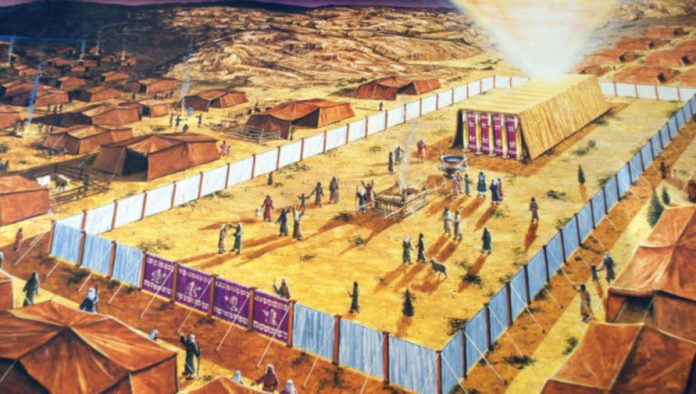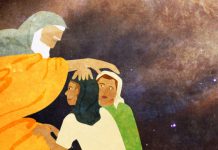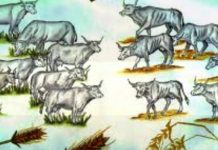The Israelites Bring Donations to Build the Tabernacle
“Of all the nerve!” cried Yankel. “Every year, I give a donation from my hard-earned money to that new yeshiva in Volozhin so that the boys can study Torah – and what do they use the money for? To buy a new suit, horse and buggy for their fundraiser. They’ll never see another red ruble from me again!”
Rabbi Chaim of Volozhin and the yeshiva fundraiser were reviewing their list of donors. “I can’t understand why Reb Yankel didn’t give a thing this year? He always gives a sizable donation. Why don’t we pay him a visit?” suggested Rabbi Chaim.
Two hours later they found themselves in Yankel’s living room. When Yankel complained about the suit and horse the rabbi explained that they helped the fundraiser make a good impression. “Anyway,” explained the rabbi, “which money goes where depends on the intention of the donor. If the donor has pure intentions, without ulterior motives, the money goes straight to the boys studying Torah. If however, the intention is less pure, then it goes to the suit of the fundraiser. Even less pure motives, it will go to the horse!” (Although still a mitzvah, it isn’t as great as the other levels.)
The Torah introduces Betzalel as the architect of the Tabernacle. (He was the grandson of Chur, who was killed trying to prevent the Golden Calf.) The Torah says that Betzalel was able to think deep thoughts – aware of all the kabbalistic secrets of the universe! Then the Torah says that he was an expert craftsman who could work with copper, silver, gold and wood. Asked Rabbi Chaim: This is a strange combination. After praising someone with knowledge of all the secrets of heaven and earth, isn’t it a little demeaning to add, “By the way, he’s also a great goldsmith and carpenter!?”
The answer, explained Rabbi Chaim, was that Betzalel was able to sense the thoughts of the donors and used the donations according to their intentions. The ones who had the best intentions, had their gold used for the “Holy of Holies.” The ones with lesser intentions, for lesser things. To know this one must understand all the secrets of the universe.
SHABBAT & THE TABERNACLE
This week’s Parsha describe the details of the construction of the Tabernacle.
Question: Why such detail? Even the Temple of Solomon in the biblical Book of Kings does not contain so many details. It’s not like we ever intend to return to the desert and rebuild it.
Answer: In two places (Exodus 31 and 35), the Torah precedes the construction of the Tabernacle with the laws of Shabbat. What is the connection between them? Answer: The oral law derives from this exactly what is forbidden on the Shabbat. The Torah says “don’t do work.” What constitutes work? Don’t build the Tabernacle on Shabbat. (Even though the temple service overrides the Shabbat, such as bringing offerings and playing music, that was only after the Temple was completed. However the construction was only considered a “preparation for the mitzvah” and was forbidden.) Once we know that you can’t build the Tabernacle on Shabbat, we can learn from the details of Tabernacle construction all of the 39 categories of forbidden work on Shabbat.
Another connection is the fact that what the Temple represents in space (a place where one can feel closer to the Almighty), Shabbat represents in time. On Shabbat, no matter where you may be physically, you are close to God.
FIRE
The Torah forbids making fire on Shabbat: “Do not ignite fire in all of your dwellings on the Shabbat” (Exodus 35:3). Although, as we mentioned, the 39 categories are derived from the construction of the Tabernacle, the Torah specifically mentions fire to tell us that we are responsible for every classification of work, and not only for doing all 39 categories.
Question: Why was fire chosen to teach us this?
Answer: Fire is essential to work in general, as it is needed to forge tools that enable us to perform all types of activities. Fire can also be seen as a reference to electricity (essentially a spark) with which one can make machines that span every category of activity. (Rabbi D. N. Lesser)
EATING CHOLENT
There is an age-old Jewish custom to keep precooked food on a small flame throughout Friday night, and to eat it steaming hot on Shabbat morning. The Sages say that “whoever does not eat ‘cholent’ (warm food) on Shabbat morning, is suspected of being a non-believer!” What is the meaning of this statement?
The Talmud refers us to the Sadducees, a group that accepted only the Written Torah but rejected the Oral Torah. There was a similar group at a much later period called the Karites (who still exist in small numbers today). They were the first “fundamentalists” who took the Bible text literally.
A famous story occurred about 200 years ago. The Karites brazenly claimed to the Sultan of Turkey that they were the original Jews, and the others came later! The Sultan demanded a public debate between a rabbi and a Karite over this issue. When arriving at the Sultan’s palace, the Karite removed his shoes, as was the custom, and left them at the door. The rabbi, however, held his shoes in his hands as he entered the Sultan’s chamber.
When asked to explain his strange behavior, the rabbi replied, “We have an old tradition that at the Burning Bush when God commanded Moses to remove his shoes, there was a Karite standing there who walked off with them.” Concluded the rabbi, ” We therefore always keep our eyes on our shoes in the presence of Karites!”
Upon hearing this, the Karite started to protest, “That is totally ridiculous! Everyone knows that in the time of Moses there were no Karites!” And that was the end of the debate.
Since the Sadducees denied the Oral Torah which connects the forbidden acts on the Shabbat with the construction of the Tabernacle, they focused on the text “Do not ignite a fire” and forbade all use of fire on Shabbat. Their homes would be dark, and they would eat only cold food on Shabbat (not fulfilling any of the other Shabbat requirements).
The Sages of the Talmud explain that the prohibition is merely to not “ignite” fire on Shabbat, but if the flame was lit before the start of Shabbat, or the food was cooked beforehand and kept warm on the fire all night long (“cholent”), then it is perfectly permissible. That’s why the Sages say: One who does not eat cholent is suspected of being a non-believer – i.e. of denying the Oral Torah.
THE PEOPLE RESPOND WITH GUSTO
The Torah describes the energy of the people to supply the building materials. “The men came with the women” (Exodus 35:22). Some explain this to mean that the women were first in line. Our tradition is that the women did not worship the Golden Calf, or sin with the spies. (How’s that for women’s lib?) And when asked to donate to the Tabernacle, they were there first.
Others understand this just the opposite, that the men who had sinned with the Golden Calf needed to atone, as it says: “Where a Baal Teshuva stands, even someone always pious cannot stand!” So they went up to a higher level than the women who never sinned in the first place.
The needed materials were quickly attained, and it was necessary to announce not to bring any more. The Torah tells us “the material was enough and had left over” (Exodus 36:7).
Question: If it was enough, that implies exactly enough. So how was there “left over”??
A Chassidic rabbi offers the following answer: If there would have been exactly enough, everyone would have been proud and haughty that their contribution was what made it. When people are conceited, God conceals His presence, so their pride would not have allowed the resting of the Shechina (Divine Presence) in the Tabernacle. Only because there was some left over, and everyone felt that maybe their donation wasn’t even used, this caused them to be humble – providing a fertile environment for the Shechina.
SPINNING THE GOATS
“And all the women, whose hearts were elevated with wisdom, spun the goats” (Exodus 35:26). But people usually spin wool, not goats!
The Sages infer from this verse that they actually spun the wool while it was still on the goats! A very innovative method, to say the least. This wool was used to create coverings for the Tabernacle. It was appropriate that this task be done by women, since the beauty of Jewish society lies in women’s modesty which brings the Divine Presence (that the Tabernacle represented).
The goat represents stubbornness. We will stubbornly stick to our values in the face of a world that is often at odds with us.
credit to aish.com












